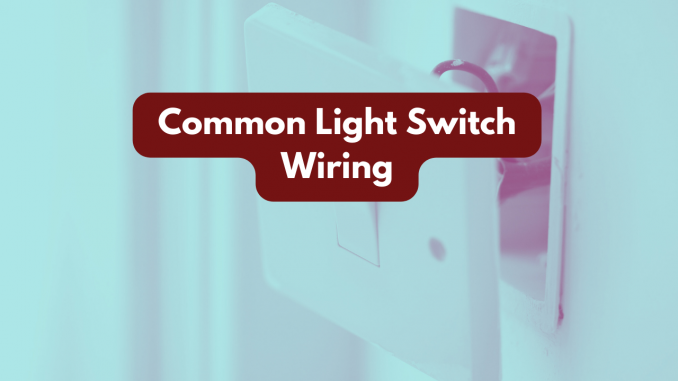
Common light switch wiring refers to the standard or typical way in which electrical wiring is configured for controlling a light fixture using a switch. In a typical residential setting, common light switch wiring involves a hot wire, a neutral wire, and a ground wire. Here’s a basic explanation:
- Hot Wire (Line or Phase): This wire carries the electrical current from the power source to the light fixture. It is typically coloured black or red.
- Neutral Wire: The neutral wire provides a return path for the electrical current. It completes the circuit and carries the current back to the electrical panel. It is usually white in colour.
- Ground Wire: This wire provides a path for electrical faults to safely dissipate into the ground, reducing the risk of electrical shock. It is typically bare or green.
- Switched Hot Wire (Load): The switched hot wire connects the light fixture to the switch. When the switch is turned on, it allows current to flow to the light fixture. It is also typically coloured black.
A common configuration involves running power from the electrical panel to the light fixture and then to the switch. The switch interrupts the hot wire, so when it is turned off, it breaks the circuit, and the light turns off. When the switch is turned on, it completes the circuit, allowing current to flow, and the light turns on.
What Does Common Mean in Wiring?
The “Common” terminal is where the live core wire is typically connected. This wire is usually brown, or on older circuits, it may be red. L1 is the terminal that links the circuit to the line going out to the light and should be paired with the blue wire. In the case of older circuits, the wire associated with L1 might appear as black.
It’s important to note that wiring practices can vary by region and local electrical codes but it shouldn’t differ depending on the height of the light switch. Additionally, there are different types of switches, such as single-pole, three-way, and four-way switches, each with its own wiring configuration for controlling lights from multiple locations. If you’re not familiar with electrical work, it’s advisable to consult a qualified electrician for any wiring projects to ensure safety and compliance with local codes.
What is the purpose of a light switch in electrical wiring?
A light switch is used to control the flow of electrical current to a light fixture. When the switch is turned on, it completes the circuit, allowing electricity to reach the light and turn it on. Turning the switch off breaks the circuit, turning off the light.
What is the difference between a single-pole and a three-way switch?
A single-pole switch controls a light fixture from one location, while a three-way switch allows control from two different locations. Three-way switches have additional traveler wires for communication between switches.
What do i do if a light switch is not working?
Check for a tripped circuit breaker, ensure proper wire connections at the switch and light fixture, and use a voltage tester to check for live wires. If issues persist, consult with an electrician.
Always prioritise safety when working with electricity, and if you’re unsure or uncomfortable with electrical work, seek the assistance of a qualified electrician.
Disclaimer: Easy Home Improvement are not qualified electricians and this post is for informational purposes only. We encourage you to seek a professional when it comes to doing your own light switch wiring.


Leave a Reply